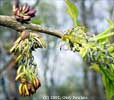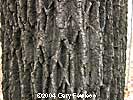
Trees of Wisconsin
|
Fraxinus americana L. white ash Family: Oleaceae |
||||||||||||||
|
||||||||||||||
|
The species of Ash are frequently misidentified, at least in part due to the mistaken impression created in some popular tree books and perpetuated in introductory classes that the species can be easily distinguished by a single character such as the bark. With experience many individuals can be accurately identified, but it is best to consider a combination of several characters and to acknowledge that some leaves, branches or even entire trees may not work well in any given key. Fraxinus americana tends to have clearly stalked leaflets with whitened undersides. The leaflets of F. pennsylvanica have short stalks and those of F. nigra are sessile (they have no stalk), and both lack a conspicuously whitened undersurface. On well developed branches of Fraxinus americana the leaf scars are often concave along the upper edge and the buds originate well within the curved portion of the leaf scar. The leaf scars of Green and Black ash are not concave along the upper edge or only slightly so. Fraxinus americana tends to occur primarily in upland forests, often with Acer saccharum. F. nigra is most often restricted to clearly wet sites. F. pennsylvanica is by far the commonest species of Ash in the southern two thirds of the state and often thrives in disturbed, young woods, both upland and lowland, and in old fields and other disturbed, open sites. The autumn leaf color of healthy F. americana trees often has a rich purplish tone or a distinctive reddish brown color, compared to the mostly yellow autumn leaves of F. nigra and F. pennsylvanica. Comparison of leaves and twigs of Fraxinus americana, F. nigra and F. pennsylvanica. Comparison of fruits for Fraxinus americana, F. nigra and F. pennsylvanica. |
|







